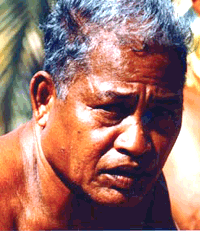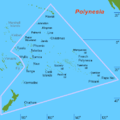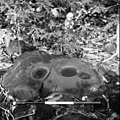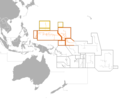Bioinformatics Wiki
The Oceania PortalOceania (UK: /ˌoʊsiˈɑːniə, ˌoʊʃi-, -ˈeɪn-/ OH-s(h)ee-AH-nee-ə, -AY-, US: /ˌoʊʃiˈæniə, -ˈɑːn-/ OH-shee-A(H)N-ee-ə) is a geographical region including Australasia, Melanesia, Micronesia, and Polynesia. Outside of the English-speaking world, Oceania is generally considered a continent, while Australia is regarded as an island or a continental landmass within that continent. Spanning the Eastern and Western Hemispheres, at the centre of the water hemisphere, Oceania is estimated to have a land area of about 9,000,000 square kilometres (3,500,000 sq mi) and a population of around 44.4 million as of 2022. Oceania is the smallest continent in land area and the second-least populated after Antarctica. Oceania has a diverse mix of economies from the highly developed and globally competitive financial markets of Australia, French Polynesia, Hawaii, New Caledonia, and New Zealand, which rank high in quality of life and Human Development Index, to the much less developed economies of Kiribati, Papua New Guinea, Tuvalu, Vanuatu, and Western New Guinea. The largest and most populous country in Oceania is Australia, and the largest city is Sydney. Puncak Jaya in Indonesia is the highest peak in Oceania at 4,884 m (16,024 ft). The rock art of Aboriginal Australians is the longest continuously practiced artistic tradition in the world. Most Oceanian countries are parliamentary democracies, with tourism being a large source of income for the Pacific island nations. (Full article...) Selected geographic article -Lanai (Hawaiian: Lānaʻi, Hawaiian: [laːˈnɐʔi, naːˈnɐʔi], /ləˈnaɪ, lɑːˈnɑːi/ lə-NY, lah-NAH-ee, also US: /lɑːˈnaɪ, ləˈnɑːi/ lah-NY, lə-NAH-ee,) is the sixth-largest of the Hawaiian Islands and the smallest publicly accessible inhabited island in the chain. It is colloquially known as the Pineapple Island because of its past as an island-wide pineapple plantation. The island's only settlement of note is the small town of Lanai City. As of 2012, the island is 98% owned by Larry Ellison, cofounder and chairman of Oracle Corporation; the remaining 2% is owned by the state of Hawaii or individual homeowners. Lanai is a roughly apostrophe-shaped island with a width of 18 miles (29 km) in the longest direction. The land area is 140.5 square miles (364 km2), making it the 43rd largest island in the United States. It is separated from the island of Molokaʻi by the Kalohi Channel to the north, and from Maui by the Auʻau Channel to the east. The United States Census Bureau defines Lanai as Census Tract 316 of Maui County. Its total population rose to 3,367 as of the 2020 United States census, up from 3,193 as of the 2000 census and 3,131 as of the 2010 census. As visible via satellite imagery, many of the island's landmarks are accessible only by dirt roads that require a four-wheel drive vehicle due to the lack of paved roadways. (Full article...) Related portalsSelected article - Pius "Mau" Piailug (pronounced /ˈpaɪəs ˈmaʊ piːˈaɪləɡ/; 1932 – 12 July 2010) was a Micronesian navigator from the Carolinian island of Satawal, best known as a teacher of traditional, non-instrument wayfinding methods for open-ocean voyaging. Mau's Carolinian navigation system, which relies on navigational clues using the Sun and stars, winds and clouds, seas and swells, and birds and fish, was acquired through rote learning passed down through teachings in the oral tradition. He earned the title of master navigator (palu) by the age of eighteen, around the time the first American missionaries arrived in Satawal. As he neared middle age, Mau grew concerned that the practice of navigation in Satawal would disappear as his people became acculturated to Western values. In the hope that the navigational tradition would be preserved for future generations, Mau shared his knowledge with the Polynesian Voyaging Society (PVS). With Mau's help, PVS used experimental archaeology to recreate and test lost Hawaiian navigational techniques on the Hōkūleʻa, a modern reconstruction of a double-hulled Hawaiian voyaging canoe. The successful, non-instrument sailing of Hōkūleʻa to Tahiti in 1976 proved the efficacy of Mau's navigational system to the world. To academia, Mau's achievement provided evidence for intentional two-way voyaging throughout Oceania, supporting a hypothesis that explained the Asiatic origin of Polynesians. The success of the Micronesian-Polynesian cultural exchange, symbolized by Hōkūleʻa, had an impact throughout the Pacific. It contributed to the emergence of the second Hawaiian cultural renaissance and to a revival of Polynesian navigation and canoe building in Hawaii, New Zealand, Rarotonga and Tahiti. It also sparked interest in traditional wayfinding on Mau's home island of Satawal. Later in life, Mau was respectfully known as a grandmaster navigator, and he was called "Papa Mau" by his friends with great reverence and affection. He received an honorary degree from the University of Hawaii, and he was honored by the Smithsonian Institution and the Bishop Museum for his contributions to maritime history. Mau's life and work was explored in several books and documentary films, and his legacy continues to be remembered and celebrated by the indigenous peoples of Oceania. (Full article...) Did you know -
General images -The following are images from various Oceania-related articles on Wikipedia.
TopicsSubcategoriesThings you can doAssociated WikimediaThe following Wikimedia Foundation sister projects provide more on this subject:
In other languagesWikipedia in other languages used in Oceania:
More portalsDiscover Wikipedia using portals Purge server cache |



















































































